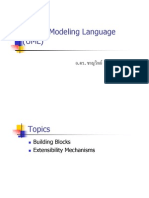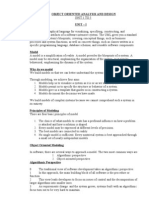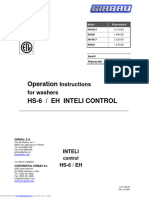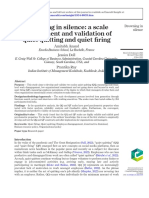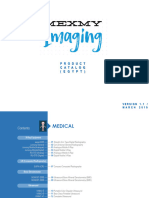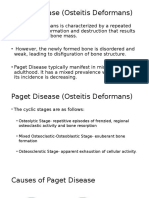Uml Record CSE
Uml Record CSE
Uploaded by
maradani nagaharikaCopyright:
Available Formats
Uml Record CSE
Uml Record CSE
Uploaded by
maradani nagaharikaOriginal Title
Copyright
Available Formats
Share this document
Did you find this document useful?
Is this content inappropriate?
Copyright:
Available Formats
Uml Record CSE
Uml Record CSE
Uploaded by
maradani nagaharikaCopyright:
Available Formats
OOAD THROUGH UML LAB CSE
The UML is a graphical language for visualizing, specifying, constructing, and documenting the
artifacts of a software-intensive system.
Class is a description of a set of objects that share the same attributes, operations, relationships,
and semantics. A class implements one or more interfaces. Graphically, a class is rendered as a
rectangle, usually including its name, attributes, and operations.
Interface
Interface is a collection of operations that specify a service of a class or component.
An interface therefore describes the externally visible behavior of that element.
An interface might represent the complete behavior of a class or component or only a part of that
behavior.
An interface is rendered as a circle together with its name. An interface rarely stands alone.
Rather, it is typically attached to the class or component that realizes the interface
I Spelling
Collaboration defines an interaction and is a society of roles and other elements that work
together to provide some cooperative behavior that's bigger than the sum of all the elements.
Therefore, collaborations have structural, as well as behavioral, dimensions. A given class might
participate in several collaborations.
Graphically, a collaboration is rendered as an ellipse with dashed lines, usually including only its
name
SRI VASAVI ENGINEERING COLLEGE (AUTONOMOUS) 1
OOAD THROUGH UML LAB CSE
Usecase
Use case is a description of set of sequence of actions that a system performs that yields
an observable result of value to a particular actor
Use case is used to structure the behavioral things in a model.
A use case is realized by a collaboration. Graphically, a use case is rendered as an ellipse
with solid lines, usually including only its name
Component is a physical and replaceable part of a system that conforms to and provides the
realization of a set of interfaces. Graphically, a component is rendered as a rectangle with tabs
Node is a physical element that exists at run time and represents a computational resource,
generally having at least some memory and, often, processing capability. Graphically, a node is
rendered as a cube, usually including only its name
Interaction
Interaction is a behavior that comprises a set of messages exchanged among a set of objects
within a particular context to accomplish a specific purpose
An interaction involves a number of other elements, including messages, action sequences and
links
Graphically a message is rendered as a directed line, almost always including the name of its
operation
State Machine
State machine is a behavior that specifies the sequences of states an object or an interaction goes
through during its lifetime in response to events, together with its responses to those events
State machine involves a number of other elements, including states, transitions, events and
activities
Graphically, a state is rendered as a rounded rectangle, usually including its name and its
substates
SRI VASAVI ENGINEERING COLLEGE (AUTONOMOUS) 2
OOAD THROUGH UML LAB CSE
Package:-
A package is a general-purpose mechanism for organizing elements into groups. Structural
things, behavioral things, and even other grouping things may be placed in a package
Graphically, a package is rendered as a tabbed folder, usually including only its name and,
sometimes, its contents
A note is simply a symbol for rendering constraints and comments attached to an element or
a collection of elements.
Graphically, a note is rendered as a rectangle with a dog-eared corner, together with a textual
or graphical comment
Relationships in the UML: There are four kinds of relationships in the UML:
1. Dependency
2. Association
3. Generalization
4. Realization
Dependency:-
Dependency is a semantic relationship between two things in which a change to one thing may
affect the semantics of the other thing
Graphically a dependency is rendered as a dashed line, possibly directed, and occasionally
including a label
Association is a structural relationship that describes a set of links, a link being a connection
among objects.
Graphically an association is rendered as a solid line, possibly directed, occasionally including a
label, and often containing other adornments, such as multiplicity and role names
SRI VASAVI ENGINEERING COLLEGE (AUTONOMOUS) 3
OOAD THROUGH UML LAB CSE
Aggregation is a special kind of association, representing a structural relationship between a
whole and its parts. Graphically, a generalization relationship is rendered as a solid line with a
hollow arrowhead pointing to the parent
Realization is a semantic relationship between classifiers, wherein one classifier specifies a
contract that another classifier guarantees to carry out. Graphically a realization relationship is
rendered as a cross between a generalization and a dependency relationship
Diagrams in the UML
Diagram is the graphical presentation of a set of elements, most often rendered as a
connected graph of vertices (things) and arcs (relationships).
In theory, a diagram may contain any combination of things and relationships.
For this reason, the UML includes nine such diagrams:
Class diagram
Object diagram
Use case diagram
Sequence diagram
Collaboration diagram
Statechart diagram
Activity diagram
Component diagram
Deployment diagram
Class diagram
A class diagram shows a set of classes, interfaces, and collaborations and their relationships.
Class diagrams that include active classes address the static process view of a system.
Object diagram
SRI VASAVI ENGINEERING COLLEGE (AUTONOMOUS) 4
OOAD THROUGH UML LAB CSE
Object diagrams represent static snapshots of instances of the things found in class
diagrams
These diagrams address the static design view or static process view of a system
An object diagram shows a set of objects and their relationships
Use case diagram
A use case diagram shows a set of use cases and actors and their relationships
Use case diagrams address the static use case view of a system.
These diagrams are especially important in organizing and modeling the behaviors of a
system.
Interaction Diagrams
Both sequence diagrams and collaboration diagrams are kinds of interaction diagrams
Interaction diagrams address the dynamic view of a system
A sequence diagram is an interaction diagram that emphasizes the time-ordering of messages
A collaboration diagram is an interaction diagram that emphasizes the structural organization
of the objects that send and receive messages
Sequence diagrams and collaboration diagrams are isomorphic, meaning that you can take one
and transform it into the other
Statechart diagram
A statechart diagram shows a state machine, consisting of states, transitions, events, and
activities
Statechart diagrams address the dynamic view of a system
They are especially important in modeling the behavior of an interface, class, or
collaboration and emphasize the event-ordered behavior of an object
Activity diagram
An activity diagram is a special kind of a statechart diagram that shows the flow from activity to
activity within a system
Activity diagrams address the dynamic view of a system
They are especially important in modeling the function of a system and emphasize the flow of
control among objects.
Component diagram
A component diagram shows the organizations and dependencies among a set of
components.
Component diagrams address the static implementation view of a system
They are related to class diagrams in that a component typically maps to one or more
classes, interfaces, or collaborations.
SRI VASAVI ENGINEERING COLLEGE (AUTONOMOUS) 5
OOAD THROUGH UML LAB CSE
Deployment diagram
A deployment diagram shows the configuration of run-time processing nodes and the
components that live on them
Deployment diagrams address the static deployment view of an architecture
Why we need UML Lab?
The UML uses mostly graphical notations to express the design of software projects. Using the
UML helps project teams communicate, explore potential designs, and validate the architectural
design of the software.The overall goal of UML diagrams is to allow teams to visualize how a
project is or will be working, and they can be used in any field, not just software engineering.
SRI VASAVI ENGINEERING COLLEGE (AUTONOMOUS) 6
OOAD THROUGH UML LAB CSE
Task-1 Draw basic Class Diagram And Object Diagram to identify and describe key
concepts like classes,and their relations for ATM?
SRI VASAVI ENGINEERING COLLEGE (AUTONOMOUS) 7
OOAD THROUGH UML LAB CSE
Object Diagram
SRI VASAVI ENGINEERING COLLEGE (AUTONOMOUS) 8
OOAD THROUGH UML LAB CSE
Task-2 Draw one or more Use Case diagrams for capturing and representing requirements
of the system. Use case diagrams must include template showing description and steps of
the Use Case for various scenarioss for ATM?
SRI VASAVI ENGINEERING COLLEGE (AUTONOMOUS) 9
OOAD THROUGH UML LAB CSE
Task- 3 Draw sequence diagrams OR communication diagrams with advanced notation
for system to show objects and their message exchanges.for ATM?
SRI VASAVI ENGINEERING COLLEGE (AUTONOMOUS) 10
OOAD THROUGH UML LAB CSE
Communication diagram
SRI VASAVI ENGINEERING COLLEGE (AUTONOMOUS) 11
OOAD THROUGH UML LAB CSE
Task- 4 Draw activity diagrams to display either business flows or like flow charts for
ATM?
SRI VASAVI ENGINEERING COLLEGE (AUTONOMOUS) 12
OOAD THROUGH UML LAB CSE
Task-5 Develop State chart diagrams for ATM?
SRI VASAVI ENGINEERING COLLEGE (AUTONOMOUS) 13
OOAD THROUGH UML LAB CSE
Task-6 Draw component diagrams assuming that build the system reusing existing
components along with a few new ones for ATM?
SRI VASAVI ENGINEERING COLLEGE (AUTONOMOUS) 14
OOAD THROUGH UML LAB CSE
Task-7 Draw deployment diagrams to model the runtime architecture of system for ATM?
SRI VASAVI ENGINEERING COLLEGE (AUTONOMOUS) 15
OOAD THROUGH UML LAB CSE
Task-8 Case study for Library Management System .
8.1Class Diagram Library Management
SRI VASAVI ENGINEERING COLLEGE (AUTONOMOUS) 16
OOAD THROUGH UML LAB CSE
Object Diagram Library Management
SRI VASAVI ENGINEERING COLLEGE (AUTONOMOUS) 17
OOAD THROUGH UML LAB CSE
8.2 Use Case For Library Management
SRI VASAVI ENGINEERING COLLEGE (AUTONOMOUS) 18
OOAD THROUGH UML LAB CSE
8.3 Sequence Diagram For Library Management
SRI VASAVI ENGINEERING COLLEGE (AUTONOMOUS) 19
OOAD THROUGH UML LAB CSE
Collaboration Diagram For Library
SRI VASAVI ENGINEERING COLLEGE (AUTONOMOUS) 20
OOAD THROUGH UML LAB CSE
8.4Activity Diagram Library Management
SRI VASAVI ENGINEERING COLLEGE (AUTONOMOUS) 21
OOAD THROUGH UML LAB CSE
8.5 State chart Diagram For Library
SRI VASAVI ENGINEERING COLLEGE (AUTONOMOUS) 22
OOAD THROUGH UML LAB CSE
8.6 Component Diagram for Library
SRI VASAVI ENGINEERING COLLEGE (AUTONOMOUS) 23
OOAD THROUGH UML LAB CSE
8.7 Deployment Diagram For Library
SRI VASAVI ENGINEERING COLLEGE (AUTONOMOUS) 24
OOAD THROUGH UML LAB CSE
Task-9 Case study for Hospital Management System.
9.1.Class Diagram for Hospital Mgmt
SRI VASAVI ENGINEERING COLLEGE (AUTONOMOUS) 25
OOAD THROUGH UML LAB CSE
Object Diagram for Hospital Mgmt
SRI VASAVI ENGINEERING COLLEGE (AUTONOMOUS) 26
OOAD THROUGH UML LAB CSE
9.2.Use Case Diagram for Hospital Mgmt
SRI VASAVI ENGINEERING COLLEGE (AUTONOMOUS) 27
OOAD THROUGH UML LAB CSE
9.3.sequence Diagram for Hospital Mgmt
SRI VASAVI ENGINEERING COLLEGE (AUTONOMOUS) 28
OOAD THROUGH UML LAB CSE
Collaboration Diagram For Hospital Mgmt.
SRI VASAVI ENGINEERING COLLEGE (AUTONOMOUS) 29
OOAD THROUGH UML LAB CSE
9.4.Activity Diagram For Hospital Mgmt
SRI VASAVI ENGINEERING COLLEGE (AUTONOMOUS) 30
OOAD THROUGH UML LAB CSE
9.5. State Chart Diagram For Hospital Mgmt
SRI VASAVI ENGINEERING COLLEGE (AUTONOMOUS) 31
OOAD THROUGH UML LAB CSE
9.6.Component Diagram For Hospital Mgmt
SRI VASAVI ENGINEERING COLLEGE (AUTONOMOUS) 32
OOAD THROUGH UML LAB CSE
9.7.Deployment Diagram For Hospital Mgmt
SRI VASAVI ENGINEERING COLLEGE (AUTONOMOUS) 33
OOAD THROUGH UML LAB CSE
Task-10 Case study for Railway Reservation System.
10.1 Class Diagram For Railway Reservation System
SRI VASAVI ENGINEERING COLLEGE (AUTONOMOUS) 34
OOAD THROUGH UML LAB CSE
Object Diagram For Railway Reservation System
SRI VASAVI ENGINEERING COLLEGE (AUTONOMOUS) 35
OOAD THROUGH UML LAB CSE
10.2 Usecase Diagram For Railway Reservation System
SRI VASAVI ENGINEERING COLLEGE (AUTONOMOUS) 36
OOAD THROUGH UML LAB CSE
10.3 Sequence Diagram For Railway Reservation System
SRI VASAVI ENGINEERING COLLEGE (AUTONOMOUS) 37
OOAD THROUGH UML LAB CSE
Collaboration Diagram For Railway Reservation System
SRI VASAVI ENGINEERING COLLEGE (AUTONOMOUS) 38
OOAD THROUGH UML LAB CSE
10.4 Activity Diagram For Railway Reservation System
SRI VASAVI ENGINEERING COLLEGE (AUTONOMOUS) 39
OOAD THROUGH UML LAB CSE
10.5 State chart Diagram For Railway Reservation System
SRI VASAVI ENGINEERING COLLEGE (AUTONOMOUS) 40
OOAD THROUGH UML LAB CSE
10.6 Component Diagram For Railway Reservation System
SRI VASAVI ENGINEERING COLLEGE (AUTONOMOUS) 41
OOAD THROUGH UML LAB CSE
10.7 Deployment Diagram For Railway Reservation System
SRI VASAVI ENGINEERING COLLEGE (AUTONOMOUS) 42
You might also like
- Diagrams in The UMLDocument14 pagesDiagrams in The UMLapi-26462544No ratings yet
- Unified Modeling Language (UML)Document84 pagesUnified Modeling Language (UML)Chanwit KaewkasiNo ratings yet
- Unit-3 Notes SE Part-IIIDocument5 pagesUnit-3 Notes SE Part-IIIsunnyvemulavadatrynow6506No ratings yet
- By: Altaf HussainDocument38 pagesBy: Altaf HussainxyznhNo ratings yet
- Unified Modelling LanguageDocument32 pagesUnified Modelling LanguageMasanam JanardhanNo ratings yet
- What Is UML?: Types of UML DiagramsDocument13 pagesWhat Is UML?: Types of UML DiagramsAnshi AryaNo ratings yet
- Types of UML DiagramsDocument22 pagesTypes of UML DiagramsAdarsha ReddyNo ratings yet
- OO Analysis and Design and UMLDocument9 pagesOO Analysis and Design and UMLMayank SharmaNo ratings yet
- Uni Fed Modeling LanguageDocument44 pagesUni Fed Modeling LanguageAmat DamuriNo ratings yet
- Uml FinalDocument70 pagesUml FinalThandavakrishnaNo ratings yet
- UML NotesDocument14 pagesUML NotesBuddhika PrabathNo ratings yet
- Unified Modeling Language: SpecifyingDocument12 pagesUnified Modeling Language: SpecifyingMounikaNo ratings yet
- Star UmlDocument9 pagesStar UmlAchintya JhaNo ratings yet
- What Is UML? What're The Purposes of UML?: UML Use Case DiagramDocument4 pagesWhat Is UML? What're The Purposes of UML?: UML Use Case DiagramqwertyuiopNo ratings yet
- Task 1Document9 pagesTask 1divijareddy0502No ratings yet
- Unified Modeling Language (Uml) : (1) ThingsDocument13 pagesUnified Modeling Language (Uml) : (1) ThingsAnand Kumar ManoharNo ratings yet
- UML-lab RecordDocument122 pagesUML-lab RecordBavya Sri Sai100% (1)
- App Dev Module 20 CopiesDocument8 pagesApp Dev Module 20 CopiesArjay BalberanNo ratings yet
- 8-UML Building BlocksDocument23 pages8-UML Building BlocksPavandeep SainiNo ratings yet
- UML DifferencesDocument11 pagesUML Differencessantanu mahalaNo ratings yet
- Software Engineering-Unit 4Document43 pagesSoftware Engineering-Unit 4anujacsNo ratings yet
- Activity DiagramDocument16 pagesActivity DiagramRonnie EdecNo ratings yet
- SDA UML ModelingDocument13 pagesSDA UML ModelingMudasser HussainNo ratings yet
- Activity DiagramDocument7 pagesActivity DiagramRAMEDANNo ratings yet
- Introduction To Unified Language Modeling: Lecturer Sara Khurshid SiddiquiDocument35 pagesIntroduction To Unified Language Modeling: Lecturer Sara Khurshid SiddiquiAsad ButtNo ratings yet
- Labmanual FullDocument97 pagesLabmanual FullSelva Kanmani67% (3)
- Sec-I A - Introduction To UMLDocument51 pagesSec-I A - Introduction To UMLNilayPatelNo ratings yet
- Chapter 2Document48 pagesChapter 2surafel123emiruNo ratings yet
- Conceptual Model of The Unified Modeling LanguageDocument22 pagesConceptual Model of The Unified Modeling Languagesalamrockybhai70077263No ratings yet
- 8 - Se Week-3Document10 pages8 - Se Week-3kaartheeka01No ratings yet
- Uml LabDocument13 pagesUml LabJayaramsai PanchakarlaNo ratings yet
- uml-m3Document144 pagesuml-m3rojan sebastianNo ratings yet
- What Is UML?: Types of UML DiagramsDocument4 pagesWhat Is UML?: Types of UML DiagramsSoumen KanrarNo ratings yet
- Case Tools & UML IntroductionDocument35 pagesCase Tools & UML Introductionpanupama1256No ratings yet
- Case ToolsDocument6 pagesCase ToolsSathyaPriya RamasamyNo ratings yet
- What Are The Five Concepts of Object Oriented LanguageDocument3 pagesWhat Are The Five Concepts of Object Oriented LanguageSakthivel GovindarajNo ratings yet
- OOAD Unit-2Document12 pagesOOAD Unit-2Trinadh MattaNo ratings yet
- UNIT 1 - UML IntroDocument28 pagesUNIT 1 - UML IntroDEVIBALA SUBRAMANIANNo ratings yet
- Lecture 5 OOADDocument65 pagesLecture 5 OOADabasazn234No ratings yet
- Chap IiDocument22 pagesChap Iivalo rantNo ratings yet
- Diagrams IntroductionDocument8 pagesDiagrams IntroductionHan JeeNo ratings yet
- Uml FinalizedDocument46 pagesUml FinalizedpujithanimmalaNo ratings yet
- Diagrams IntroductionDocument9 pagesDiagrams IntroductionHan JeeNo ratings yet
- UML DescriptionDocument18 pagesUML Descriptionvamsi.d124No ratings yet
- Ooad Unit 22Document43 pagesOoad Unit 22SumanthvarmaNo ratings yet
- Complete UML DiagramsDocument38 pagesComplete UML DiagramsUmesh Walunjkar100% (1)
- OOAD 2 ND UnitDocument40 pagesOOAD 2 ND Unitawesomegamer786786No ratings yet
- Unit - I: Write About Principles of Modeling?Document9 pagesUnit - I: Write About Principles of Modeling?dh_kumarNo ratings yet
- TALHA NADEEM 11610 CS 5thDocument15 pagesTALHA NADEEM 11610 CS 5thtalhanadeem02No ratings yet
- RIS Section 2Document8 pagesRIS Section 2sohila abo ghanamNo ratings yet
- Case Tools List of ProgramsDocument34 pagesCase Tools List of ProgramsStuti GuptaNo ratings yet
- 1.6-Types of UML DiagramsDocument8 pages1.6-Types of UML DiagramsUmar FarooqNo ratings yet
- Ooad Lecture Notes, Unit 1 To 5Document72 pagesOoad Lecture Notes, Unit 1 To 5vamsidhar200886% (7)
- UML Lab Manual PDFDocument56 pagesUML Lab Manual PDFSrinadh ShaikNo ratings yet
- Uml DiagramsDocument22 pagesUml DiagramsPavan KalyanNo ratings yet
- Unit-2 Notes OosdDocument35 pagesUnit-2 Notes Oosdad.lusifar007No ratings yet
- Enterprise Interoperability: INTEROP-PGSO VisionFrom EverandEnterprise Interoperability: INTEROP-PGSO VisionBernard ArchimèdeNo ratings yet
- Washington Irrevocable Living TrustDocument8 pagesWashington Irrevocable Living TrustandreadeniselewisestateNo ratings yet
- New Comp Model Rate SheetDocument2 pagesNew Comp Model Rate SheetVisual SyncNo ratings yet
- Introduction To Soft DrinksDocument4 pagesIntroduction To Soft DrinksRavi Shetty50% (2)
- Chapter 2 - Stages of MultimediaDocument10 pagesChapter 2 - Stages of MultimediaWan Khairul IkhwanNo ratings yet
- Hazard Flooding A4 LandscapeDocument1 pageHazard Flooding A4 LandscapejeloelydacumosNo ratings yet
- Logistics and Supply Chain OperationsDocument13 pagesLogistics and Supply Chain OperationsaleenawaltersNo ratings yet
- Professional Huawei Cdma Smartax Ma5300 Huawei Smartax Ma5600-97178401 PDFDocument2 pagesProfessional Huawei Cdma Smartax Ma5300 Huawei Smartax Ma5600-97178401 PDFelgaro1405No ratings yet
- GIRBAU HS-6013 Operation Instructions Manual (EN)Document49 pagesGIRBAU HS-6013 Operation Instructions Manual (EN)ivanov87nvkzNo ratings yet
- Stock Market Book by Ca Aaditya JainDocument198 pagesStock Market Book by Ca Aaditya JainVijaya100% (3)
- 5StarS WhitePaper 12 6 19 PDFDocument28 pages5StarS WhitePaper 12 6 19 PDFChristoph SchmittnerNo ratings yet
- 1 OMFB PTOsDocument19 pages1 OMFB PTOsAttral HONo ratings yet
- 10 Years From Now ForDocument5 pages10 Years From Now ForJohn Brian Asi AlmazanNo ratings yet
- Sessiz Istifa Ölçeği 10-1108 - IJOA-01-2023-3600Document23 pagesSessiz Istifa Ölçeği 10-1108 - IJOA-01-2023-3600Mustafa ŞEKERNo ratings yet
- Perspectives: Overcoming Challenges and Dogmas To Understand The Functions of PseudogenesDocument11 pagesPerspectives: Overcoming Challenges and Dogmas To Understand The Functions of Pseudogenesİzem DevecioğluNo ratings yet
- Target Retail ProjectDocument13 pagesTarget Retail ProjectConnor MarshmanNo ratings yet
- How It Works Aim Focus Conclusion Introduction To Artificial IntelligenceDocument8 pagesHow It Works Aim Focus Conclusion Introduction To Artificial IntelligenceAbdulkadier AbdelaNo ratings yet
- Biomedical Uses and Applications of Inorganic Chemistry. An OverviewDocument4 pagesBiomedical Uses and Applications of Inorganic Chemistry. An OverviewHiram CruzNo ratings yet
- Mexmyimaging - Total Brochure - V1.1 (Egypt)Document15 pagesMexmyimaging - Total Brochure - V1.1 (Egypt)servicesNo ratings yet
- Tesira Ex-Mod Manual May14-1Document28 pagesTesira Ex-Mod Manual May14-1Rachmat Guntur Dwi PutraNo ratings yet
- SyllabusDocument3 pagesSyllabusfvcdslyf 11No ratings yet
- Paget Disease (Osteitis Deformans)Document14 pagesPaget Disease (Osteitis Deformans)Orson SimonNo ratings yet
- AviationHistory FlorianPetrescuDocument217 pagesAviationHistory FlorianPetrescuDAVID FAJARDO PUERTONo ratings yet
- (Google Interview Prep Guide) SRE SWEDocument4 pages(Google Interview Prep Guide) SRE SWESheunesu GumbieNo ratings yet
- ELS ONE39 EL+Retarder-Prover 208-60 US1 GIACDocument11 pagesELS ONE39 EL+Retarder-Prover 208-60 US1 GIACFreddy MayorgaNo ratings yet
- English For Academic and Professional PurposesDocument4 pagesEnglish For Academic and Professional PurposesSamantha RullaNo ratings yet
- Department of Education: Oral Reading VerificationDocument3 pagesDepartment of Education: Oral Reading Verificationkian josefNo ratings yet
- Ôn thi tiếng Anh A2 - 20 đề ngheDocument44 pagesÔn thi tiếng Anh A2 - 20 đề ngheNguyễn Văn Trường100% (1)
- Psat NMSQT Exam JZhjdschdsDocument60 pagesPsat NMSQT Exam JZhjdschdsLauren Kasow100% (1)
- PolarographyDocument18 pagesPolarographyAmithra S NairNo ratings yet
- GMR Institute of Technology, Rajam: Department of Computer Science & EngineeringDocument31 pagesGMR Institute of Technology, Rajam: Department of Computer Science & EngineeringSai GurunadhNo ratings yet

